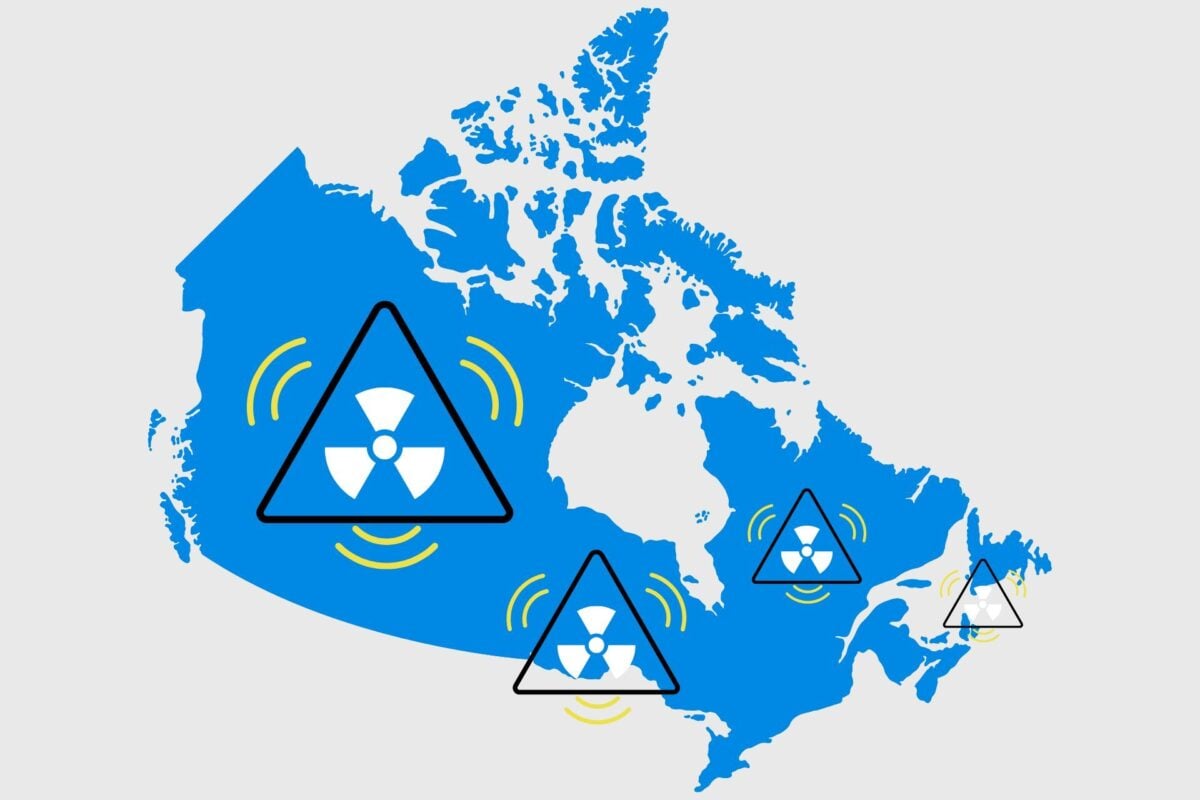Blog Summary:
- Radon is a gas produced when uranium, thorium or radium-containing minerals in the soil break down. When radon is captured, contained, and concentrated in homes and buildings, it can create a significant lung cancer risk.
- Radon exposure can be dangerous for anyone, and radon can exist in any type of home, anywhere in Canada.
- The best way to know whether the level of radon in your home is dangerous is to use a Health Canada approved long-term testing kit. The Evict Radon National Study can provide these kits at cost with unbiased research ethics board-approved information on radon testing and mitigation, all the while helping advance cancer prevention research in Canada.
Radon is a radioactive gas produced as uranium, thorium, or radium-containing minerals in the ground break down. When radon is captured, contained, and concentrated to unsafe levels in our homes, it becomes a significant cancer risk factor for Canadians—but accurate information on radon can be difficult to come by, and numerous myths persist among the general public. The work we do at The Evict Radon National Study aims to educate Canadians about radon’s risk and provide access to resources that can help them safeguard their homes.
Below, we drill down into 7 of the most common myths about radon, including those surrounding the testing and mitigation process. Learn more about the dangers of radon, who can be affected, and how easy it can actually be to have your home tested and mitigated.
Want to know your home’s radon levels? Order a radon test kit here.
Myth #1: Radon Has Been around Forever and It Isn’t Dangerous
Because radon is tasteless and odorless, has been around for a long time, and is generated naturally by the earth, many people assume it poses no danger to their health.
However, modern radon exposure is not natural at all, and the exceptionally high levels that we’re being exposed to now have only arisen since the 20th century, as our building habits have evolved. In fact, radon exposure in Canada has never been higher, and is now linked to over 3,300 deaths per year across the country, making it a pressing and ongoing public health problem. A Canadian is diagnosed with a radon-induced lung cancer every hour and 48 minutes.
The levels of radiation associated with radon released from the soil do not normally pose a health risk to humans, as it naturally dissipates in the open air or leaks out of the more open, drafty buildings (such as wooden huts, old stone buildings, castles, etc.) humans have built for centuries.
However, unnaturally high radon exposure has, in recent decades, become a serious and widespread health concern as it concentrates within modern buildings, where the cancer-causing radiation it emits can reach dangerous levels not usually seen in nature outside of deep underground caves. In fact, the radiation levels we are seeing from radon in Canada today have not been around forever, and are dangerous.

Myth #2: Radon Will Only Affect Me If I Smoke Tobacco
Another commonly held belief among Canadians is that radon only presents a significant health risk to people who already smoke tobacco products. However, although people who frequently smoke tobacco and live in homes with high radon levels face an exponentially greater cancer risk than comparable individuals who live in homes with less radon, this doesn’t make people who do not smoke tobacco safe from radon’s effects.
In reality, radon exposure is the leading cause of lung cancer in Canadians who do not smoke tobacco. Regardless of whether you smoke tobacco a lot or even a little, you should take precautions to test the radon levels in your home and lower them if necessary.
The absorbed doses of radiation from radon that are being documented in Canada today are unprecedented. Many exceed maximum tolerated exposure limits for nuclear energy workers, and are comparable to many hundreds of thousands of x-rays worth of radiation per year in extreme cases.
Myth #3: Some Parts of Canada Are “Radon Free”
Radon exists in every part of Canada, irrespective of provincial or territorial boundaries. There is no part of the country where you can be sure homes won’t have dangerous radon levels.
While the average number of homes with dangerously high radon varies between different geographical areas, there is no such thing as a part of Canada where radon risks are negligible. In fact, the five major Canadian regions all rank within the top 20 areas surveyed on the list of places with the highest residential radon levels in the world.
Myth #4: Radon Testing Is Difficult
Even when homeowners understand the importance of radon testing, some put off the process because they assume it will be difficult, expensive, or time consuming. In fact, obtaining the device necessary for accurate radon testing is convenient, relatively affordable, and the testing process itself is simple, likely taking you only minutes to set up and later return to get your outcomes.
One of the best ways to test radon levels in your home is by using an alpha-track device, which can measure radon levels reliably over a 90+ day period, even up to a year. These devices are about the size of a hockey puck, and do not use your home’s electricity supply.
As a non-profit, research ethics board approved citizen science study intended to raise awareness about radon risks throughout Canada, The Evict Radon National Study offers these testing kits at cost to anyone enrolling in our work. Purchasing your kit through us also allows you to participate in our cancer research efforts to gather data and information that is being used now to improve the health and reduce the future burden of cancer for people throughout the country.

Myth #5: Some Homes Don’t Need Radon Testing
Another common myth about radon is that newer homes, or older homes, or certain other types of homes don’t require testing. This simply isn’t true. Not only can high radon levels be found in any part of Canada, they can and do appear in homes regardless of their size, age, or market value.
Our research shows that new homes in Canada are being built with some of the highest average radon levels ever seen—so the only way to know your home is radon free is to test it with the proper equipment. However, it is advisable to wait at least 18 months after a new home foundation has been poured before starting your test. This is because it takes at least that long for your foundation to “cure” fully—meaning completely dry and thus shrink a bit at the edges. Only after this process has been completed will radon levels in a home stabilize.
Myth #6: Radon Mitigation Can Alter Your Home’s Value
The prospect of radon mitigation occasionally creates anxiety among homeowners who fear that installing a mitigation system will raise concerns about the air quality and make their property less appealing to potential buyers. However, this is entirely untrue. Over the many decades since such systems have been installed in houses, they have been found to be safe and actually increase home values.
Indeed, radon mitigation systems are very often seen by buyers and real estate professionals as selling points—since they indicate that efforts have been made to improve the home’s air quality and lower the risk of lung cancer for the inhabitants. Homes with radon mitigation systems are more likely to attract buyers, and both the Canadian and US real estate communities report that they are not a reason for loss of interest in any home on the market.
Myth #7: Your Neighbour’s Radon Test Results Can Indicate Radon Levels In Your Home
Finally, some people believe that if their neighbours have found low radon levels in their homes, there’s no need for them to test their own. Sadly, there is no truth to this whatsoever.
In fact, household radon levels can vary significantly from one home to the next, even if they are right next door to one another. Incidentally, this is another reason why radon maps that show average levels per province or territory can often lead people to mistakenly assume radon testing is unnecessary for them.
In reality, it is nearly always the case that radon levels will be quite different between neighbours. This is because high levels are a product not only of an individual property’s characteristics, but also the behaviour and habits of those living inside.
Just because your neighbour’s house has safe radon levels doesn’t mean yours does too—and by that same logic, high radon levels in a neighbour’s home don’t necessarily mean yours are high either! The only way to know for sure is to get your own Health Canada approved long-term radon test kit and use it to measure radon levels in your home.
Dispel Harmful Radon Myths & Breathe Easier
While radon itself is a pressing public health concern for Canadians, the myths about it can be dangerous as well. As the information we’ve shared above shows, radon can exist at dangerous levels anywhere in Canada, and the only way to know for sure whether you need radon mitigation is to test your home properly.
For help obtaining a Health Canada approved long-term test kit at cost, finding a list of C-NRPP certified professionals who can provide reliable radon mitigation services, or to learn more about our unbiased third-party study, contact The Evict Radon Radon National Study. One of our research team members will be happy to provide you with information you can use to make safer choices for your home and loved ones.
